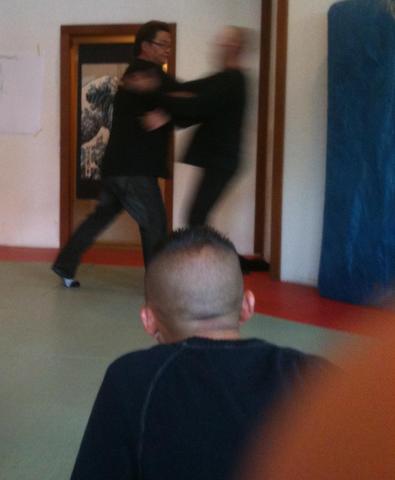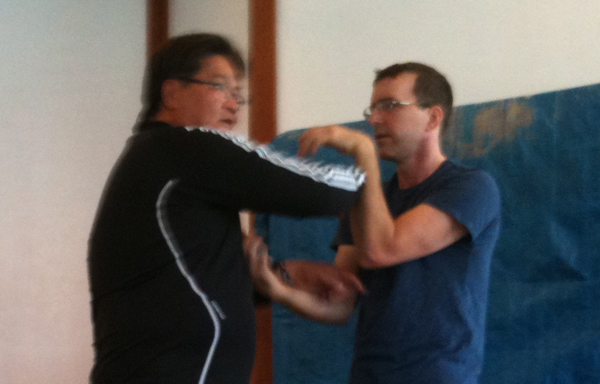
Why Gary Lam Kicked My Ass
June 25, 2012
Gary Lam was taught the first part of Wing Chun’s first form (Siu Lum Tao) by Ip Man. He learned Chi Sao from Wong Shun Leung.
He knew or met all those guys you’ve only read about.
One of the most respected Wing Chun masters in the world, he was for a time head coach for Wong Shun Leung. He was the undefeated champion of the Hong Kong full Contact Tournament in 1978-1979, and a former President of the Hong Kong Wing Chun Society.
And yesterday he kicked my ass.
Touching hands with Gary Lam is a sobering experience.
His power speaks volumes for the effectiveness of Wing Chun. My teacher Greg LeBlanc tells the story (recently recounted in an article in Wing Chun Illustrated Issue #6) about how he first met Gary Lam.
Greg wasn’t looking for Wing Chun in particular or even kung fu – he had studied akido extensively and some other martial arts and was only in the market for what he describes as structure .
He saw a Chinese herbalist doing some martial arts moves and learned about Sifu Gary Lam, who lived nearby. A friend of his was looking for some kung fu training so they went over Sifu Lam’s house to check it out. They had both trained extensively in other martial arts.
Sifu Lam showed them, right there in the kitchen, why Wing Chun is a high-level skill. They felt it. In the demonstrations he did with Greg’s friend, he knocked him around easily, moving him as if he weighed very little although he was a bulky bodybuilder. They realized his fighting was at another level and both signed up on the spot.
Its hard to explain structure but you know it when you come into contact with it. Its like you have run into someone with superpowers.
Here is a Youtube video of Gary Lam in his backyard back in the late 90s:
That’s my teacher Gregory LeBlanc on the business end of Gary Lam’s Wing Chun.
Wing Chun trains you to have a stable base and to not fall down or be easily pushed over. But the higher levels of Wing Chun involve learning to take away those qualities. When you meet someone like Gary Lam who has the high level kung fu burned into his DNA, he easily takes away all of your stability, then he gives you a little push and you look like this:
Next thing you know you are “flying away” as Gary Lam calls it.
When Gary Lam trapped my hands and hit me, it seemed … inevitable.
The most striking (!) thing about his Wing Chun is how natural his movements are – more than forty years of training have made his technique part of his nervous system. As Bruce Lee would have said, it is the way that is no way. His kung fu is automatic, natural, and reflexive.
This was especially clear to me as he casually continued his lecture to the seminar attendants while trapping, hitting, and tripping me.
Gary Lam’s way of understanding and teaching the Wing Chun system has evolved from what he learned from Wong Shun Leung and Lok Yiu. He gained fighting experience and mixed in his other life experience and has produced something subtly different.
This difference is most apparent in his Five Elements method of organizing the system. He took his knowledge of Wu Xing, the Chinese philosophical system of Five Elements (wood, fire, earth, metal, water) and used this framework to organize and understand and inter-relate the Wing Chun system.
He broke Wing Chun up into five sections: crossing hands (changing), pushing (timing), pulling (surprise), closing (take position), and footwork (power points). I am only scraping the top of the iceberg here.
When I was still training in another lineage of Wing Chun, I saw the video on this system – this was my first exposure to Gary Lam. I didn’t understand it – it was over my head. But I saw how he moved so easily and how his opponents went down without much effort on his part.
Another aspect of the system he spoke about Sunday is, in my experience, unique to the Wong Shun Leung / Gary Lam lineage is the idea of Geng Ging. In the beginning of Bruce Lee’s Enter the Dragon, he instructs a student to include “emotional content” in his attacks, but “not anger.”
Wong Shun Leung and Gary Lam (and Gregory LeBlanc ) teach you to include emotional content, but it is anger or even hate . Strong emotion enables you to launch an explosive, vicious attack. Sifu Lam says you have to be “a little bit of a monster” to survive a life and death struggle. As a peaceful person most of the time, you need to learn to tap into your dark side with the flip of a switch in order to “attack the attack” with 100%.
Geng ging helps you unleash the beast and set it on the attacker, but in a controlled way, a conscious and deliberate way.
This is one of the things I love about Wing Chun training. It lets you let the beast off the chain, just a little bit . When you train in drills or Chi Sao, and your partner is good enough to handle a very strong attack, you can get it out, just a little. Its great for your mental health.
How can you tell if your martial art is effective? What if its all bullshit – how would you know? In martial arts training, the teacher rarely says “attack me with all your might.”
We are taught something and then the “fighting” we do is within the context of what we were taught. You are taught a “game” and then you play by its rules.
Since I started at 15, I’ve studied under 11 martial arts teachers. It took me a long time to become a discerning consumer of martial arts instruction. I had to try some of things I was taught in the real world and discover what I had been taught was not very effective.
Probably the fault was in me, but I suggest these acid tests for those, who, like me, are looking for training that will stand up to the street.
Number One: The system is based on actual fighting experience.

In martial arts, there are many systems and styles which are based on “secrets” from long ago and not questioned or tested in this century – this is the “Classical mess” Bruce Lee spoke about.
Does Wing Chun pass this test?
Gary Lam has full contact fighting experience. He learned Muay Thai in Thailand and then taught it in his Hong Kong school. He won the Hong Kong full contact championship for 1979/79 against all comers.
His teacher, Wong Shun Leung, fought more than 60 bare knuckle fights to knockout in “skill tests” in 1950s Hong Kong.
Number Two: the teacher can demonstrate the skills, under significant and random pressure.
You can throw whatever punch or kick you want as fast as you want at Gregory LeBlanc or Gary Lam – they will efficiently smother your attack and hit you hard. I’ve been on the receiving end of both of their skills and there is no doubt. You feel it. They can demonstrate it without rehearsal.
Before the seminar last Sunday, I asked Sifu Lam (he is actually my Sigung, which means my teacher’s teacher) about his Muay Thai experience and which kicks were effective. I like this Muay Thai kick to the Peroneal nerve (on the outside of the thigh, just above the knee) which I have been training.
I tried it on Greg a few times but he easily shelled up and kept me from executing it. Maybe this kick isn’t so great, I thought.
Sifu Lam demonstrated a couple of kicks he liked on Greg (who probably wasn’t thanking me for asking this question) and then he showed me a couple – a flip kick to the outside and then a casually thrown sweeping kick that laid his shin across the back of my thighs like a pipe. This one made a sound heard across the room.
Luckily, I didn’t fall down, but it smarted, let me tell you. I can still feel its stinging effects three days later.
It was worth it though – now I can tell my students that Gary Lam kicked my ass.

